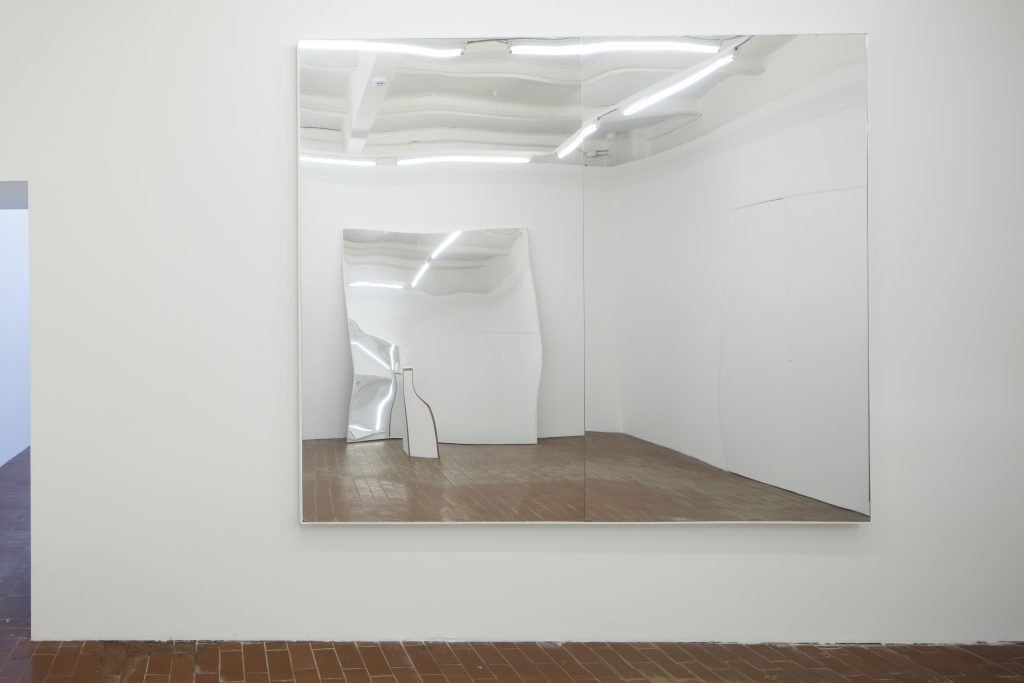As part of the new exhibition cycle Ojārs Pētersons, professor at the Art Academy of Latvia, is presenting his third solo-exhibition at Kim? titled second hand. Photographs and second hand ready-mades, once used daily, these may well be permanent works, but through reciprocity they create an altogether new image. Situated the centre of Kim? exhibition space, right in-between current and past students’ work, Pētersons’ exhibition functions as an intermediary.
Notes on the exhibition
1. Two mirrors, a photograph, objects in a showcase, sound, something orange.
I am trying to list the works that might be displayed in this exhibition. While I await an e-mail from Ojars, which should help to articulate what is to be exhibited. Such e-mail doesn’t arrive, and the opening is fast approaching. Above listed objects, might just as well not even nd their way into the display. Currently, I only have two paragraphs on my hands, which have been pulled out of the Latvian translation of Robert Smithson’s collection of writings and a few quotes from Claude Lévi-Strauss. One can’t help but wonder if Ojars has selected quotes from Lévi-Strauss’ Savage Mind (1962) as a particular and meaningful gesture that further forms a direct link with the forthcoming exhibition? “Its object is to grasp the world as both a synchronic and a diachronic totality and the knowledge which it draws therefrom is like that aorded of a room by mirrors xed on opposite walls, which reflect each other (as well as objects in the intervening space) although without being strictly parallel.” These lines does not clear anything up, but at this point I am not seeking an answer. It does, however, create reason to believe that it might function as a frame for Ojars’ mentioned mirrors.
2. I meet up with Ojars with soon-to-come exhibition in mind, and things do become a bit more clear after all. Impatiently sketching and scribbling with a ballpoint pen on a piece of paper, he tells me that the exhibition will be called second hand. There will be sound included and it sound will be static. Exhibition will occupy two rooms, yet the works visible in the rst space will have no direct relation to the works seen in the second. In general the exhibition will be about “nothing”.
Later, I receive an image in my e-mail, of a white porcelain water jug with “Agua” written across it in blue letters. The disclosed amount of information increases a little once more, yet what is expected plunge into a further more deeper mist.
3. Even as I write these notes, it seems that the eorts to compose a descriptive text or to immerse in the characterization for Ojars’ works would endanger they much guarded distance.
I quickly began to adhere to the conclusion that over-analyzing Ojars’ words or works would be incredibly tedious and restrictive. This would inevitably lead to a repetitive trap. The same old phrases would be constantly in use, which could just as easily be related to anything even remotely similar to an artwork. Therefore it is safer to comply with this ironic distance, a characteristic feature of an artist himself, from everything that might be considered to be meaningful and serious within his practice. All in all not only Ojars’ artworks, but also his remarks and replies on all sorts of questions are encouragements not to just coax some explanatory sentences or to comprehend what lies beyond the obvious, but to distance oneself and ponder the supposed self-evident features of contemporary art. For requests aer articulated explanations, for the failure to comment on the mute and reticent, for the viewers desires for depth, “contemporaneousness”, intellectual saturation and so on.
Tomass Pā rups
Ojārs Pētersons (born in 1956) graduated from the Woodcarving Department of the Applied Arts School of Riga (in 1975) and then the Industrial Art Department of the Art Academy of Latvia (in 1980). He has been exhibiting since 1975. In the 1980s, he actively collaborated with artists Andris Breže, Juris Putrāms as well as Henrihs Vorkals. Pētersons has participated in several exhibitions abroad including the 23rd San Paulo Biennale (in 1996), and within the Latvian National Pavilion at the 48th Venice Biennale together with Inta Ruka and Anta Zabiļevska (in 1998). Currently Ojārs Pētersons is a professor in the Visual Communications Department at the Art Academy of Latvia, and works as the Department Head for Motion, Image and Sound.
